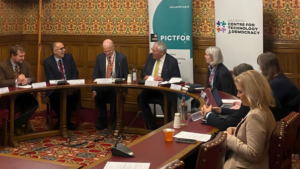
Modernising government for AI: What key challenges do departments face?
Civil servants across government are dealing with the same challenges, often in isolation. Every department wants to better use data and explore AI but legacy systems and fragmented information still make that difficult.
Meanwhile, capability gaps, cultural readiness and budget pressures continue to slow progress, even when intent is high.
Many of these challenges resonate with what we see every day across government.
And conversations I had with civil servants during the recent Central Government Partnership Network (CGPN) event confirmed this.
- One civil servant spoke about the pressure to utilise AI but she didn’t know where or how to begin.
- Another pointed out that in the rush for AI, seniors often forget the constraints of outdated systems and the need to modernise. As he told me, “How can we even begin to think about AI when we’re still manually copying data from one system to another?”
- And then there’s the capability gap and lack of knowledge transfer in the public sector. Attendees said they were at the event to learn about what others were doing and what’s working.
Key challenges from data
These conversations were consistent with data collected by CGPN.
Civil servants who attended the event wrote about their current key challenges on the CGPN portal.
We undertook a quick analysis of those challenges to identify broader trends — effectively, we itemised the challenges and categorised them into the most suitable themes to see what concerns emerged on top.
Our analysis reveals three interconnected themes driving the government’s digital agenda.

The AI imperative and data foundations
The most frequently cited challenge is AI adoption and data (36%). Attendees wrote phrases like “AI integration”, “procuring AI”, “using AI to increase efficiency”, and “AI ethics.”
It suggests that while organisations want to use AI, they are unsure about its practical implementation.
Since AI models require high-quality data to function effectively, people also cited challenges around data ‘quality’, ‘accuracy’, and ‘governance’. The frequent mentions of AI and data in tandem showed that the attendees recognise that successful AI adoption is pegged to preparing strong data foundations first.
Our AI readiness white paper explores many of these themes, including how to build strong data governance and move from pilots to scalable AI. Read it here
Digital transformation and legacy modernisation
As mentioned, to successfully adopt AI, departments need to fix the foundations. A lot of government data sits trapped in legacy systems and processes — digitising and modernising unlocks this potential.
Civil servants listed challenges like “modernisation”, “digital transformation”, and “retiring legacy systems” in 28% of the responses. The data suggests that moving away from old infrastructure and legacy systems to adopt scalable solutions like “cloud-based platforms”, and indeed even AI, remains a critical barrier for many teams.
Departments want faster, lower-risk modernisation and are looking at how to consolidate and connect their platforms. We’ve seen this through our work helping departments move beyond legacy constraints and prepare for AI.
For example, we transformed a legacy process into an award-winning platform for the Home Office. For Border Force, we digitised and modernised their workflows and then explored AI to improve operations further.
Skills gap and cultural transformation
But transformation isn’t a tech issue; it’s a people issue too. That’s why the attendees flagged challenges around ‘organisational and cultural transformation’ (11%) as well as ‘skills and capability’ (10%).
Terms like ‘upskilling’, ‘skills gap’ and ‘investment in people’ show the difficulties in hiring or retaining staff with the right capabilities.
Likewise, challenges in “cross-sector collaboration”, “embracing innovation” and “cultural transformation” highlight the wider issues around organisational readiness.
From the work we’ve done with government clients, achieving alignment and consensus between stakeholders at the start of a project goes a long way to addressing some of the cultural and organisational barriers.
Focused workshops, like Transformation Days, help bring the right people together to reach alignment and overcome blockers. We know it’s easier said than done; getting the right people in a room. But from our experience, it’s a crucial first step that you just need to make happen.
Meanwhile, organisations can address the skills gap by partnering with suppliers who commit to upskilling internal teams during the engagement.
For instance, on the ScanApp project, we trained civil servants to run the solution themselves once our work was complete. Every contractual arrangement should include knowledge transfer to build long-term capability within government.
Ultimate goal: boost productivity, realise efficiencies
For government organisations, there is increasing pressure to move faster, smarter, and with greater security.
The vocabulary used by some delegates to define their challenges — such as ‘efficiency,’ ‘productivity,’ and ‘cut costs’ — shows that, regardless of the approach, the outcome remains the drive to deliver more value at a lower cost.
The government’s focus on AI reflects this. From the AI Opportunities Action Plan to the recent spending review, AI is seen as a key enabler of efficiency and productivity — so it’s no surprise that it appears foremost in the minds of many civil servants.
Equally, it’s clear why legacy systems, data, people, and organisational culture are also high on the list of concerns. Because without those foundational elements, you can’t see the benefits of AI.
What next?
- Read white paper: Check out “Unlocking Government Efficiency: An AI Readiness Roadmap for Decision Makers.” It offers practical guidance on integration, readiness assessment, and planning a way forward for AI in public services.
- Watch webinar series: Check out our ‘AI in government: From modernisation to implementation’ webinar series. Learn how experts from the Home Office, Cabinet Office, and the Department for Business and Trade are paving the way for AI in their teams.
Related content
-
Regulatory Documents
-

Enhancing care quality through data-driven insights and AI integration
-

Zaizi founder Aingaran Pillai named chair of techUK’s Security and Public Safety SME Forum
-

Zaizi ‘Highly Commended’ for Best Employer at 2025 Computing Women in Tech Excellence Awards
-

PICTFOR roundtable: Is regulation a handbrake or a catalyst to public trust and innovation in AI?
-

Beyond blueprints: Making government transformation real
